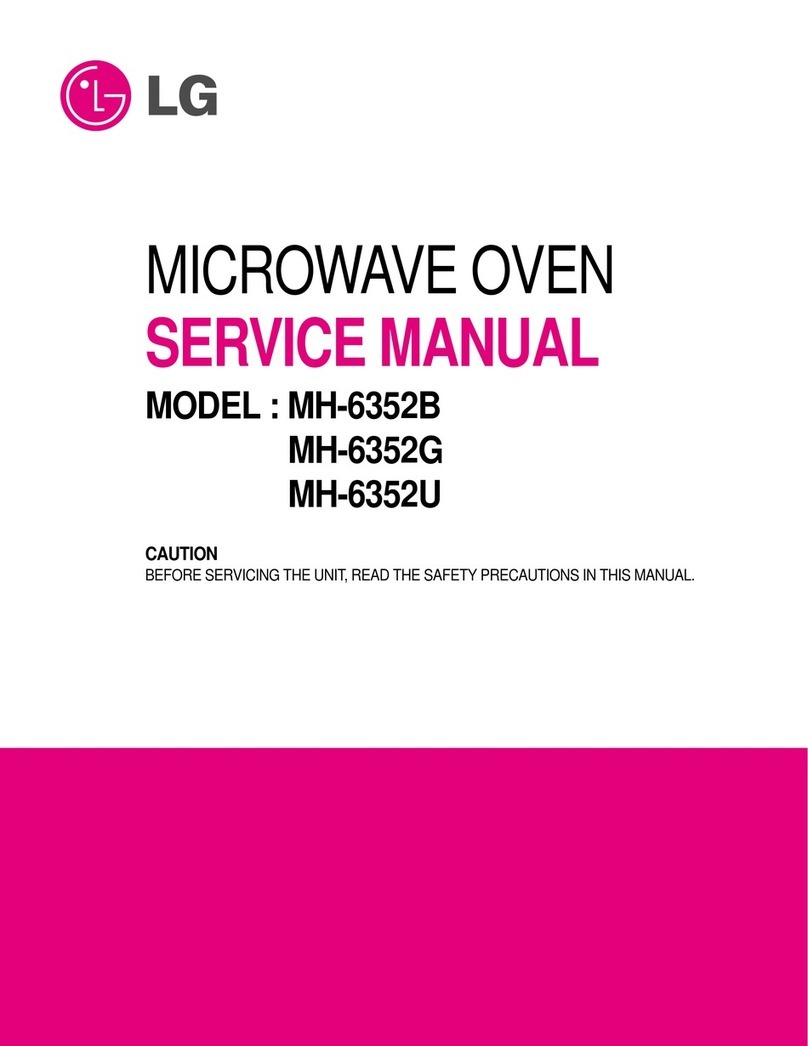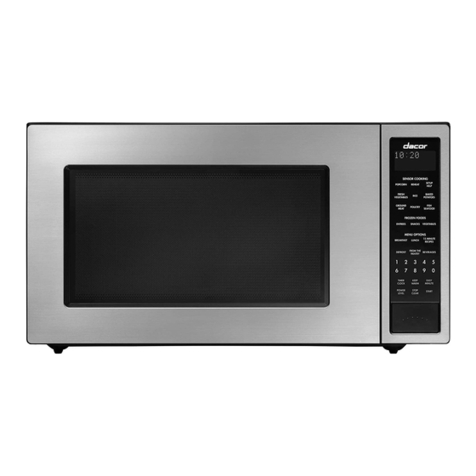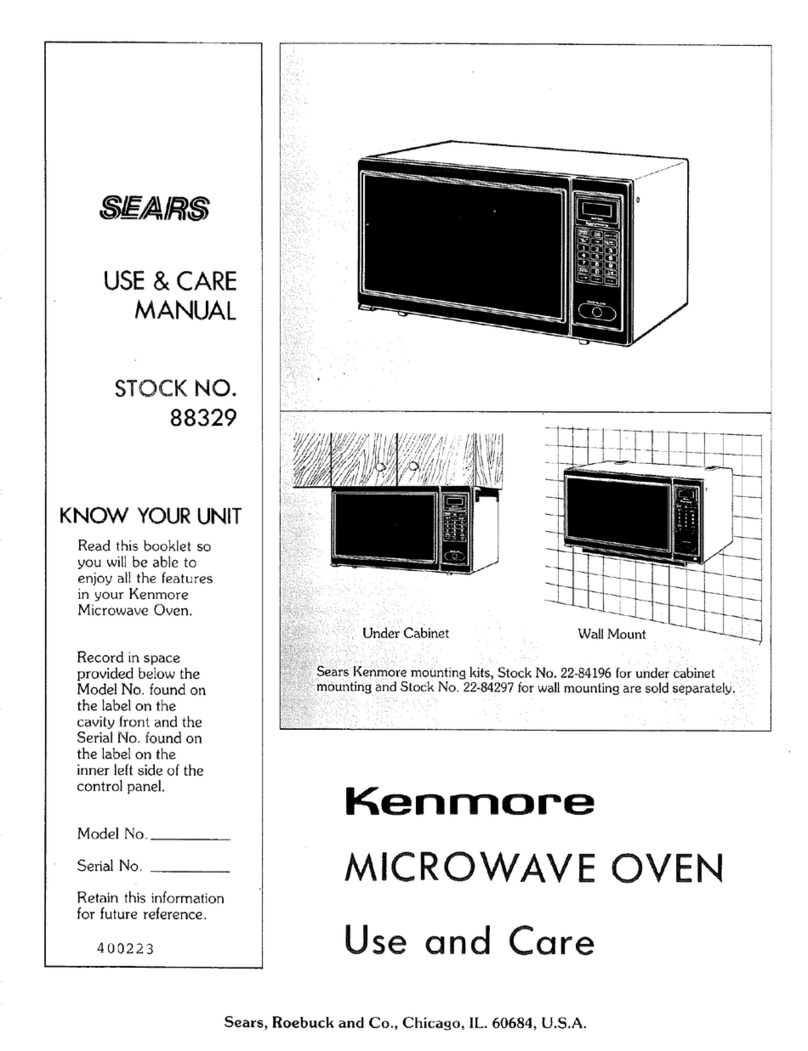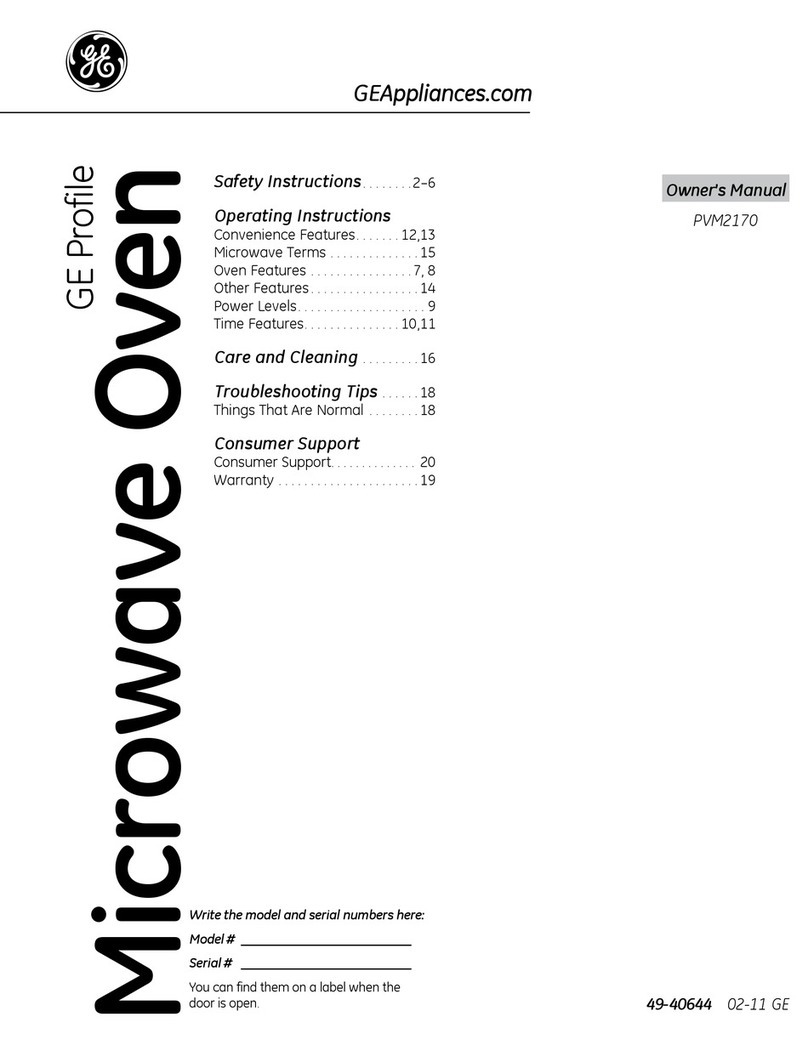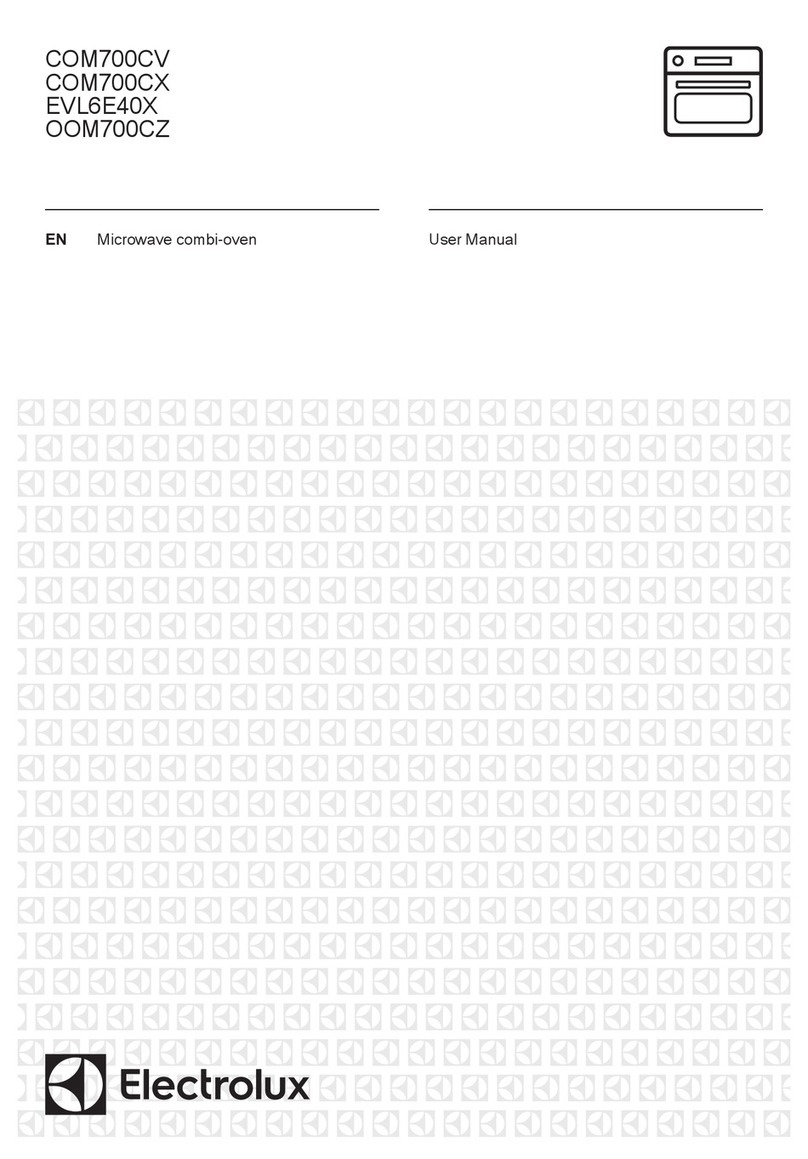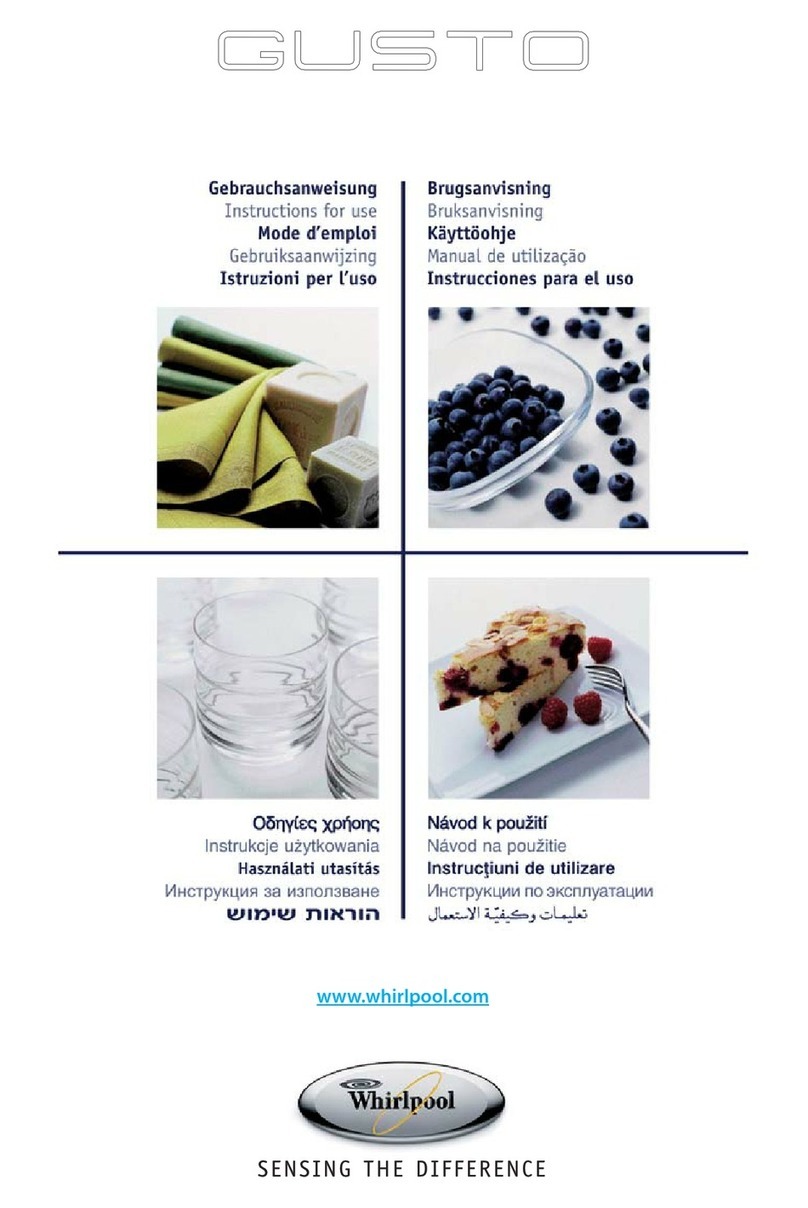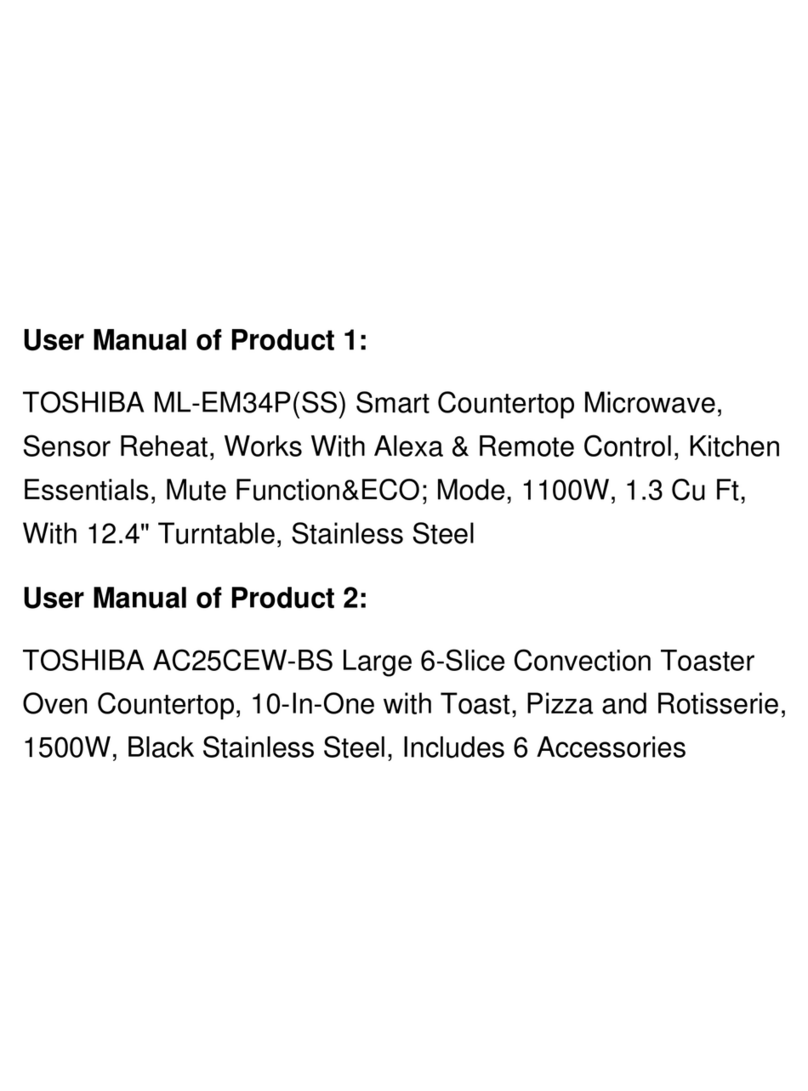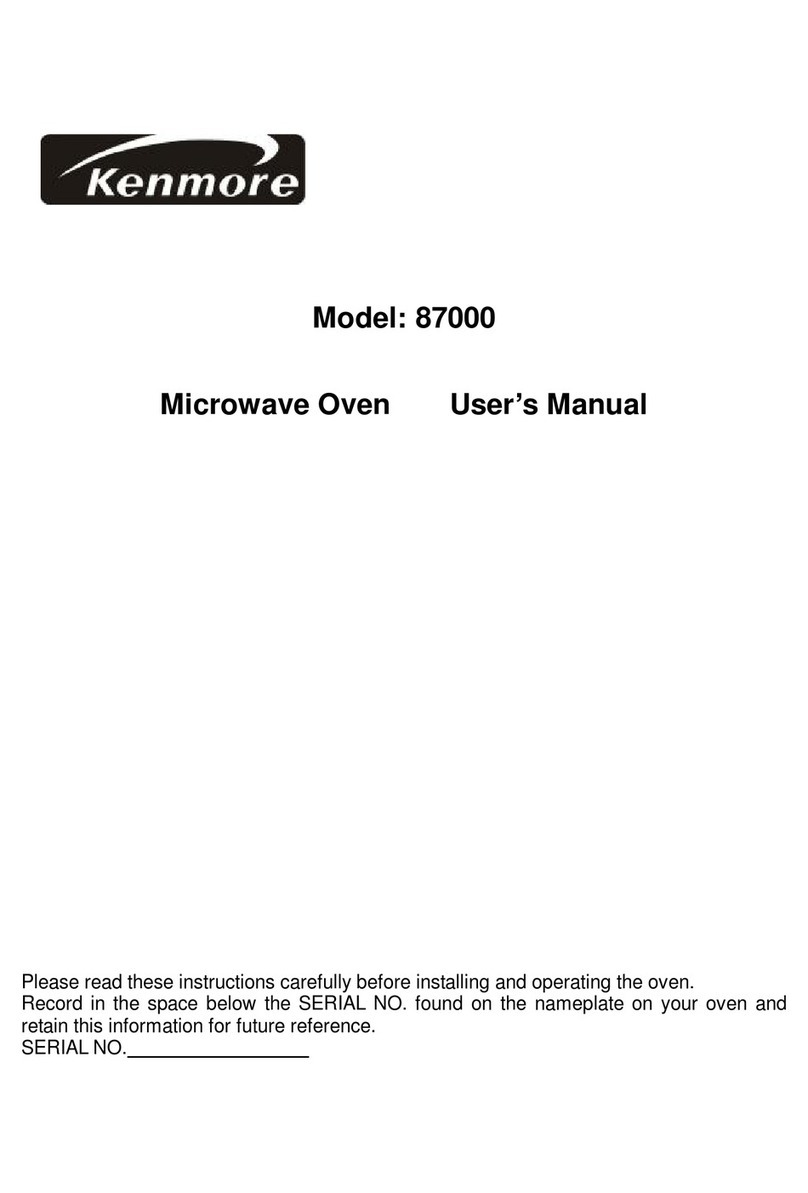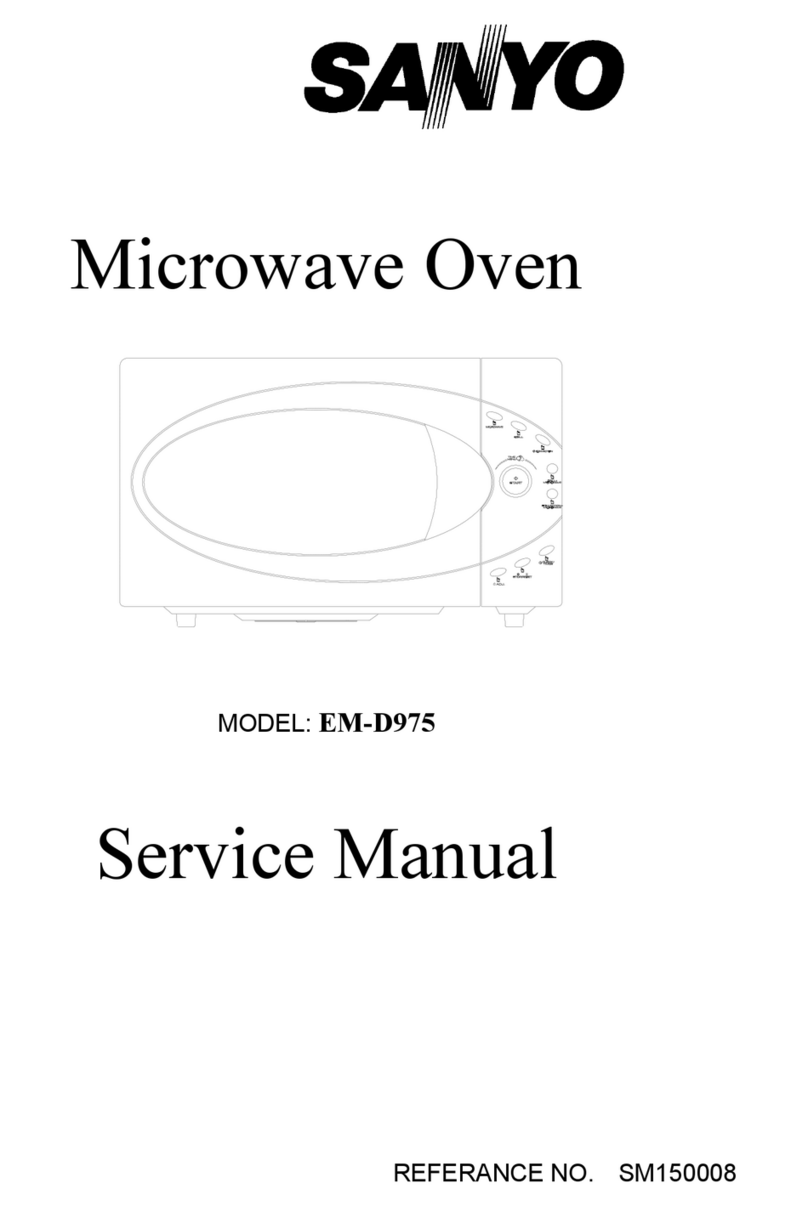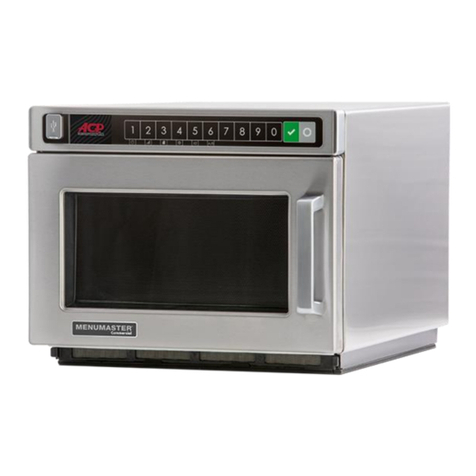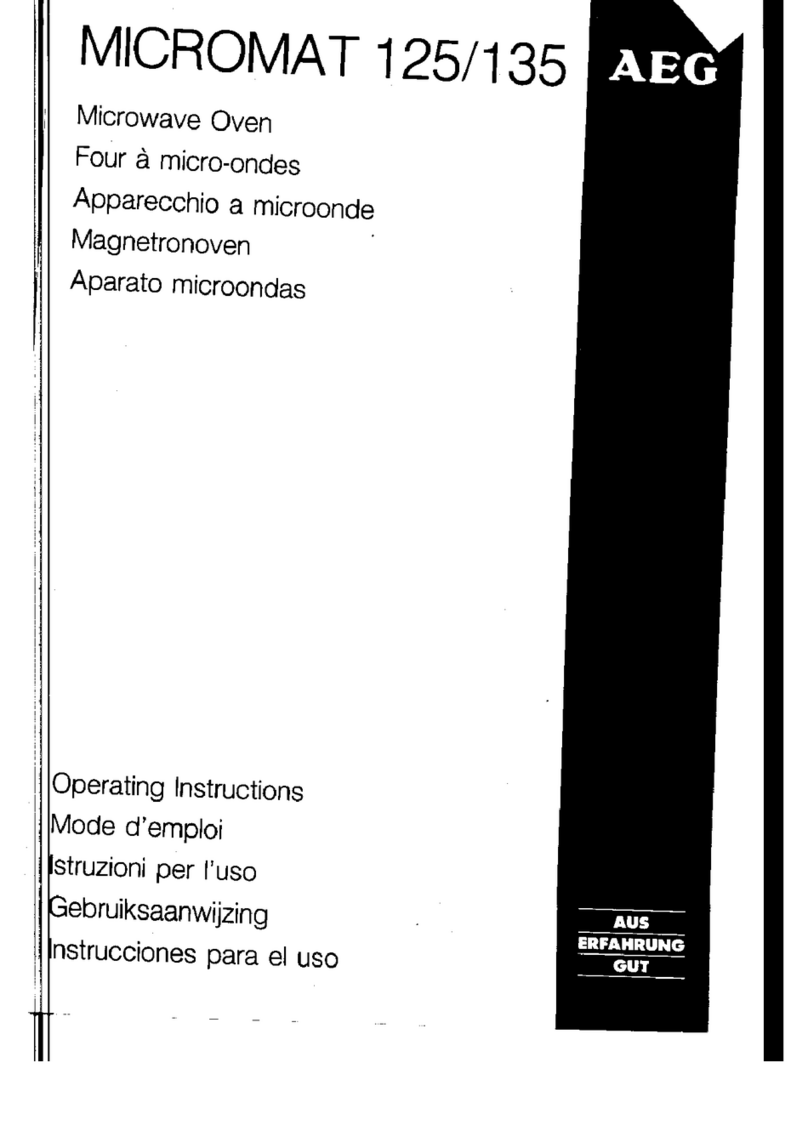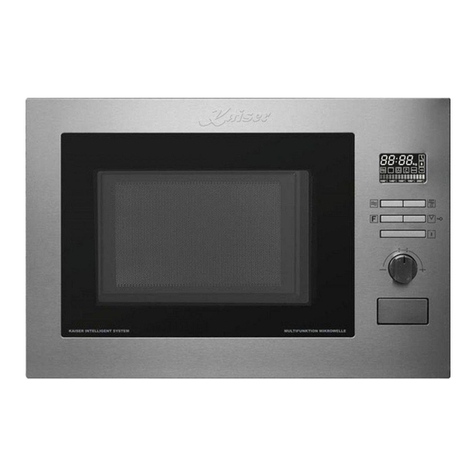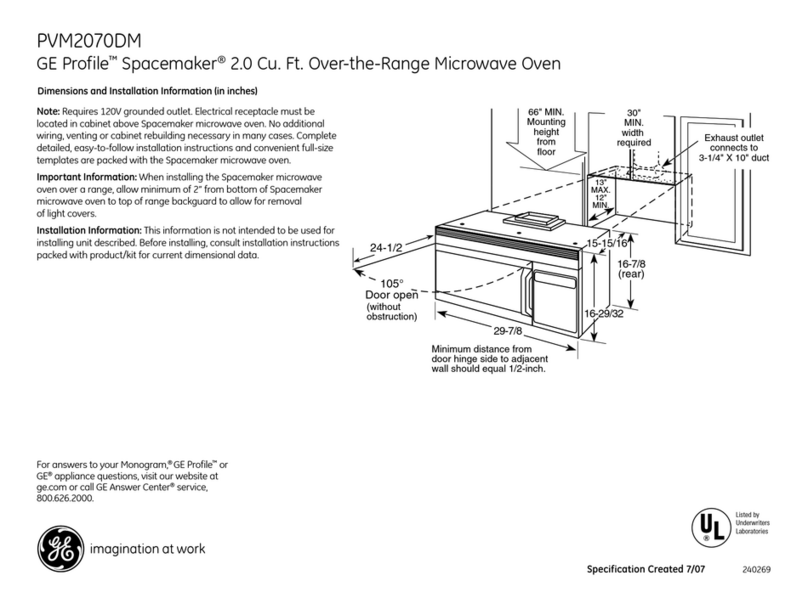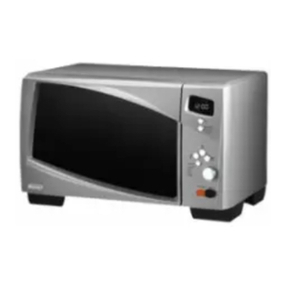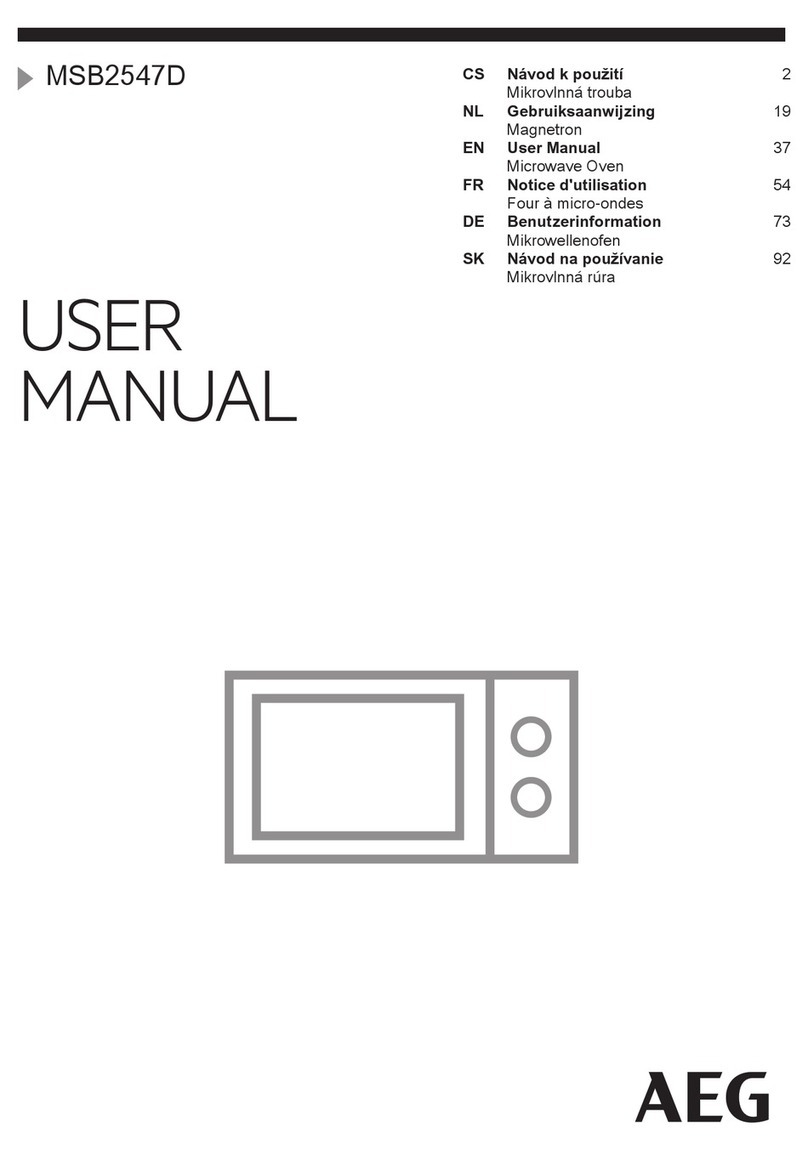Solwave SWAFP Series User manual

Keep these instructions for future
reference. If the equipment changes
ownership, be sure this manual
accompanies equipment. Please refer to
the SAFETY INSTRUCTIONS for important
safety information prior to using this oven
Owner’s Manual
COMMERCIAL MICROWAVE OVEN
THIS OVEN IS INTENDED FOR COMMERCIAL USE ONLY
This document covers SWAFP* models
TABLE OF CONTENTS
Important Safety Instructions.........................................2-3
Grounding and Installation.............................................. 4
Control Panel and Features............................................. 5
Cooking & Programming Features ................................. 6
Using the Oven Control ................................................... 7
Programming .................................................................... 8
Export Menu via USB Flash Drive................................... 9
Import Menu via USB Flash Drive................................... 9
User Options.................................................................... 10
Care and Cleaning.........................................................11-12
Cooking Guidelines......................................................... 13
Cooking Instructions....................................................... 15
Before Calling for Service............................................... 16

©2020 Solwave ovens
Lancaster, Pennsylvania,17603 Page 2 of 16
Part No. 20152604
Original Instructions
SAVE THESE INSTRUCTIONS
PRECAUTIONS TO AVOID POSSIBLE EXPOSURE TO
EXCESSIVE MICROWAVE ENERGY
A. DO NOT attempt to operate this oven with the door open since open door operation can result in harmful exposure to
microwave energy. It is important not to defeat or tamper with the safety interlocks.
B. DO NOT place any object between the oven front face and the door too allow soil or cleaner residue to accumulate on sealing
surfaces.
C. DO NOT operate the oven if it is damaged. It is particularly important that the oven door close properly and that there is no
damage to the:
1. door (bent)
2. hinges and latches (broken or loosened)
3. door seals and sealing surfaces.
D. The oven should not be adjusted or repaired by anyone except properly qualied service personnel.
1. READ all instructions before using equipment.
2. READ AND FOLLOW the specic “PRECAUTIONS
TO AVOID POSSIBLE EXPOSURE TO EXCESSIVE
MICROWAVE ENERGY”.
3. This equipment MUST BE GROUNDED. Connect only
to properly GROUNDED outlet. See “GROUNDING/
EARTHING INSTRUCTIONS”.
4. Install or locate this equipment ONLY in accordance with the
installation instructions in this manual.
5. Some products such as whole eggs and sealed containers—
for example, closed glass jars—are able to explode and
SHOULD NOT be HEATED in this oven.
6. Use this equipment ONLY for its intended use as described
in this manual. DO NOT use corrosive chemicals or vapors
in this equipment. This type of oven is specically designed
to heat, cook, or dry food. It is not designed for industrial or
laboratory use.
7. As with any equipment, CLOSE SUPERVISION is
necessary when used by CHILDREN.
8. DO NOT operate this equipment if it has a damaged cord or
plug, if it is not working properly, or if it has been damaged
or dropped.
9. This equipment, including power cord, must be serviced
ONLY by qualied service personnel. Special tools are
required to service equipment. Contact nearest authorized
service facility for examination, repair, or adjustment.
10. DO NOT cover or block lter (if applicable) or other openings
on equipment.
11. DO NOT store this equipment outdoors. DO NOT use this
product near water – for example, near a kitchen sink, in a
wet basement, a swimming pool, or a similar location.
12. DO NOT immerse cord or plug in water.
13. Keep cord AWAY from HEATED surfaces.
14. DO NOT let cord hang over edge of table or counter.
15. See door cleaning instructions on page 11. Cleaning and
user maintenance shall not be made by children without
supervision.
16. To avoid risk of re in the oven cavity:
a. DO NOT overcook food. Carefully attend oven when
paper, plastic, or other combustible materials are placed
inside the oven to facilitate cooking.
b. Remove wire twist-ties from paper or plastic bags
before placing bag in oven.
c. If materials inside the oven ignite, keep oven door
CLOSED, turn oven o and disconnect the power cord,
or shut o power at the fuse or circuit breaker panel.
d. DO NOT use the cavity for storage. DO NOT leave
paper products, cooking utensils, or food in the cavity
when not in use.
17. For commercial use only.
18. It is hazardous for anyone other than a competent person
to carry out any service or repair operation that involves
the removal of any cover which gives protection against
exposure to microwave energy.
19. If the door or door seals are damaged, the oven must not be
operated until it has been repaired by a competent person.
20. Appliance is not to be used by children 8 years and below
or persons with reduced physical, sensory or mental
capabilities or lack of experience and knowledge, unless
they have been given supervision or instruction.
21. Children being supervised not to play with appliance.
22. Only use utensils that are suitable for use in microwave
oven.
23. When heating food in plastic or paper containers, keep an
eye on the oven due to the possibility of ignition.
24. If smoke is observed, switch o or unplug the appliance and
keep the door closed in order to stie any ames.
25. Failure to maintain the oven in a clean condition could lead
to deterioration of the surface that could adversely aect
the life of the appliance and possibly result in a hazardous
situation.
26. The appliance should not be cleaned with a water jet (for
appliances intended to stand on the oor and which are not
at least IPX5).
27. The appliance is NOT to be cleaned with water jet or steam
cleaner.
28. Liquids or other foods must not be heated in sealed
containers since they are liable to explode.
29. Microwave heating of beverages can result in delayed
eruptive boiling, therefore care must be taken when handling
the container.
To reduce the risk of burns, electrical shock, re, or personal injury when using electrical equipment, basic safety
precautions should be followed:
IMPORTANT SAFETY INSTRUCTIONS
⚠RECOGNIZE THIS SYMBOL AS A SAFETY MESSAGE
⚠WARNING

©2020 Solwave ovens
Lancaster, Pennsylvania,17603 Page 3 of 16
Part No. 20152604
Original Instructions
IMPORTANT SAFETY INSTRUCTIONS
⚠RECOGNIZE THIS SYMBOL AS A SAFETY MESSAGE
General Use:
1. DO NOT use regular cooking thermometers in oven. Most
cooking thermometers contain mercury and may cause an
electrical arc, malfunction, or damage to oven.
2. Never use paper, plastic, or other combustible materials that are
not intended for cooking.
3. When cooking with paper, plastic, or other combustible materials,
follow manufacturer’s recommendations on product use.
4. DO NOT use paper towels which contain nylon or other synthetic
bers. Heated synthetics could melt and cause paper to ignite.
5. To avoid surface deterioration, keep the oven in a clean condition.
Infrequent cleaning could adversely aect the life of the appliance
and possible result in a hazardous situation.
6. Clean oven regularly and remove any food deposits.
Heating Foods and Liquids:
7. Liquids such as water, coee, or tea are able to be overheated
beyond the boiling point without appearing to be boiling due to
surface tension of the liquid. Visible bubbling or boiling when
the container is removed from the microwave oven is not
always present. THIS COULD RESULT IN VERY HOT LIQUIDS
SUDDENLY BOILING OVER WHEN A SPOON OR OTHER
UTENSIL IS INSERTED INTO THE LIQUID. To reduce the risk of
injury to persons:
a. DO NOT overheat the liquid.
b. Stir the liquid both before and halfway through heating it.
c. DO NOT use straight-sided containers with narrow necks.
d. After heating, allow the container to stand in the microwave
for a short time before removing it.
e. Use extreme care when inserting a spoon or other utensil
into the container.
8. DO NOT deep fat fry in oven. Fat could overheat and be
hazardous to handle.
9. DO NOT cook or reheat eggs in shell or with an unbroken yolk
using microwave energy. Pressure may build up and erupt.
Pierce yolk with fork or knife before cooking.
10. Pierce skin of potatoes, tomatoes, and similar foods before
cooking with microwave energy. When skin is pierced, steam
escapes evenly.
11. DO NOT heat sealed containers or plastic bags in oven. Food or
liquid could expand quickly and cause container or bag to break.
Pierce or open container or bag before heating.
12. DO NOT heat baby bottles in oven.
13. Baby food jars shall be open when heated and contents stirred or
shaken before consumption, in order to avoid burns.
14. Never use oven to heat alcohol or food containing alcohol as it
can more easily catch re if overheated.
Additional Microwave Oven Safety
Instructions:
15. DO NOT operate equipment without load or food in
oven cavity.
16. Use only popcorn in packages designed and
labeled for microwave use. Popping time varies
depending on oven wattage. DO NOT continue to
heat after popping has stopped. Popcorn will scorch
or burn. DO NOT leave oven unattended.
17. DO NOT use metal utensils in oven.
18. DO NOT use aluminum foil in oven
19. To avoid pacemaker malfunction, consult physician
or pacemaker manufacturer about eects of
microwave energy on pacemaker.
20. An authorized servicer MUST inspect equipment
annually. Record all inspections and repairs for
future use.
To avoid risk of personal injury or property damage, observe the following safety instructions:
SAVE THESE INSTRUCTIONS
⚠CAUTION

©2020 Solwave ovens
Lancaster, Pennsylvania,17603 Page 4 of 16
Part No. 20152604
Original Instructions
Grounding/Earthing Instructions
Oven MUST be grounded. Grounding reduces risk of electric shock
by providing an escape wire for the electric current if an electrical
short occurs. This oven is equipped with a cord having a grounding
wire with a grounding plug. The plug must be plugged into an outlet
that is properly installed and grounded.
Consult a qualied electrician or servicer if grounding instructions are not
completely understood, or if doubt exists as to whether the oven is properly grounded.
Do NOT use an extension cord.
If the product power cord is too short, have a qualied electrician install a three-slot receptacle. This oven should be plugged into
a separate circuit with the electrical rating as provided in product specications (available on Solwave’s website at
www.solwaveovens.com) and the oven’s serial plate / rating label. When the oven is on a circuit with other equipment, an
increase in cooking times may be required and fuses can be blown.
EXTERNAL EQUIPOTENTIAL EARTHING TERMINAL (export only)
Equipment has secondary earthing terminal. Terminal provides external earthing connection used in addition to earthing
prong on plug. Located on outside of oven back, terminal is marked with symbol shown at right
Installation
Unpacking Oven
• Inspect oven for damage such as dents in door or inside oven cavity.
• Report any dents or breakage to source of purchase immediately.
Do NOT attempt to use oven if damaged.
• Remove all packing materials from oven interior.
• If oven has been stored in extremely cold area, wait a few hours before
connecting power.
• A protective lm is used to prevent scratching of the outer case during
transportation. Peel o the lm from the exterior of the oven before installation.
• The warning label provided with the oven must be placed in a conspicuous
location near the oven.
Radio Interference
Microwave operation may cause interference to WiFi network, radio, television, or a
similar oven. Reduce or eliminate interference by doing the following:
• Clean door and sealing surfaces of oven according to provided instructions.
• Place WiFi network, radio, television, etc. as far as possible from oven.
• Use a properly installed antenna on radio, television, etc. to obtain stronger signal
reception.
Oven Placement
• Do NOT install oven next to or above source of heat, such as pizza oven or deep
fat fryer. This could cause oven to operate improperly and could shorten life of
electrical parts.
• Do NOT block or obstruct oven lters. Allow access for cleaning.
• Install oven on level counter-top surface.
• Outlet should be located so that plug is accessible when oven is in place.
OVEN CLEARANCES
A. Allow at least 7” (17.78 cm) of clearance around top of oven. Proper air ow
around oven cools electrical components. With restricted air ow, oven may not
operate properly and life of electrical parts is reduced.
B. There is not an installation clearance requirement for the back of the oven.
C. Allow at least 1” (2.54 cm) of clearance around sides of oven.
D. Install oven so oven bottom is at least 3 feet (91.5 cm) above oor.
⚠WARNING
Excessive Weight Hazard
Use two or more people to move
and install oven. Failure to do so can
result in back or other injury
⚠WARNING
To avoid risk of electrical shock or
death, this oven must be grounded
and plug must not be altered.
Grounding and Installation
A
B
C
D
A
D
B
C
A
B
C
D
A
D
B
C

Manual
00:50
Stage: 1
MW: 100%
Item: 05 Stage: 1
01:23 MW: 50%
Ready
©2020 Solwave ovens
Lancaster, Pennsylvania,17603 Page 5 of 16
Part No. 20152604
Original Instructions
Preprogrammed number
keypad
Cooking time
Current stage of cook cycle.
Indicates oven is ready to operate
User specied percentage of microwave power
Indicates oven is in a manual cooking mode
Cooking information
shows during cook
cycle
Indicates oven is ready to operate.
The operator may press keypads to
begin preset programs.
General Display Screens
Control Panel and Features
(A)(B)(C)(D)
(K)(L)(M)
(E)(G)(H)(I)(J)(F)
Control Panel Features
(A) USB PORT
Standard USB ash drive compatible. Allows for import/export of
programmed settings and user options.
(B) X2 -DOUBLE QUANTITY COOKING
Increases a preset cook time by a percentage of the original cook
time, also know as a COOK FACTOR. Used for cooking multiple
servings of foods .For instructions on how to use this feature, see
“Programmed Keys” on page 7
(C) MENU A/B
Toggles menu selection between two sets of programmed cook
settings. Selecting Menu A allows preset programs 0 through 9
to operate using keypads 0 through 9. Selecting Menu B allows
preset programs 10 through 19 to operate using keypads 0-9.
(D) MANUAL TIME ENTRY MODE
Allows the operator to heat without changing the preset program
keypads.
(E) DISPLAY
(F) NUMBER KEYPADS
Used to operate preset cooking programs and enter settings.
(G) START/OK KEYPAD
Begins cooking in Manual Time Entry Mode.
(H) STOP/RESET KEYPAD
Interrupts operation, and/or exits modes and menus
(I) HIDDEN KEYPAD
The hidden key pad can be used for adjusting oven controls
based on user preferences. It is located to the right of the STOP
pad. For instructions on how to use this, see “User Options” on
page 10.
(J) CONTROL KNOB
The control knob, located to the right of the number pads, can
be used for several dierent purposes. If enabled, the user may
turn the knob to either add or subtract time from the total cooking
time. Or, the user may push on the knob to start a selected
cooking cycle, if enabled. To learn how to enable this feature, see
“User Options” on page 10.
(K) POWER LEVEL KEYPAD
The power level keypad allows the user to change the microwave
power level for dierent stages of a cook cycle. For instructions
on how to program the power level, see “Programming Keys” on
page 8
(L) STAGE COOKING KEYPAD
A user can program up to four dierent stages combining both
power levels and time changes per keypad. Each combination is
known as a stage. See “Programming Multiple Stages” on page
8 for more information about stage cooking.
(M) PROGRAM SAVE KEYPAD
Programs or settings can be changed and saved based on a
user’s preference. For instructions on saving changes, see
“Programming Keys” on page 8

©2020 Solwave ovens
Lancaster, Pennsylvania,17603 Page 6 of 16
Part No. 20152604
Original Instructions
Microwave Cooking
Microwave cooking uses high
frequency energy waves to
heat the food. When cooking,
microwave energy causes food
molecules to move rapidly. This
rapid movement between the food
molecules creates heat, which
cooks the food.
Is it safe to run a
microwave if it is empty?
Running a microwave without a
load can cause serious damage
to electrical components. When
food is placed in the oven,
microwave energy generated by
the magnetron is absorbed by
the food. When no food is in the
oven, there is nothing to absorb
the energy. The energy bounces
around the cavity and is channeled
back through the waveguide. This
can cause arcing, re and may
burn out the magnetron.
How do you defrost food
while using a commercial
microwave?
Not all commercial microwaves
have the defrost button that is
commonly found on a residential
microwave. To defrost, simply use
20% microwave power level.
How do you know if a
container is microwave
safe?
To test if a container is microwave
safe, place it in the microwave
next to a container of water that
is micro-wave safe. Run the
microwave for one minute. If the
tested container is warm or hot, it is
not microwave safe.
Cooking & Programming Features
Programming Features
STAGE COOKING
Allows operator to use up to four dierent cooking cycles or stages consecutively
without repeated input from the operator. For example, stage cooking could be set to
defrost food initially, then cook it, and then keep the food warm until serving time.
PRESET PROGRAM KEYPADS
Oven can store between 10 to 100 cooking programs in memory.
A. Single Digit Keypad Cooking
From the factory, the oven is programmed to store 10 cooking programs (0-9). Each
keypad begins a cooking program.
B. Double Digit Keypad Cooking
The oven control can be changed to store up to 100 cooking programs (00-99). Each
entry will be assigned a double digit number, for example 01, 05, or 20. When using
the double keypad programming, two keypads must be pressed to start the cooking
cycle.
Note: To set control to Double Digit Entry, see “User Options” section in this manual
TOP OR BOTTOM ONLY COOKING
Top Only or Bottom Only cooking allows the user to use only the top or
bottom of the microwave during a cooking cycle. When “Top Only” is
selected, only the top magnetrons operate. When “Bottom Only” is selected
only the bottom magnetrons operate. See “Programming Top & Bottom
Only Cooking” on page 8 for more information about this feature.
MID-CYCLE COOKING PAUSE
The cooking pause is a feature unique to this series of microwaves. This pause
enables extra ingredients to be added, cooking progress to be checked, or for food
to sit for a necessary time between cooking cycles. During a mid-cycle cooking
pause, the microwave beeps continuously and PROGRAM PAUSED displays until
the oven door is opened and closed. To continue the cycle, press the START button.
To utilize this feature, see “Programming Mid-Cycle Cooking Pause” on page 9
Methods of Cooking & Programming
COOKING WITH PRESET PROGRAM KEYPADS
Allows operator to quickly activate saved cooking sequences using 1-2 keypad
strokes
MANUAL TIME ENTRY COOKING
Allows operator to heat without changing the preset program keypads
MANUAL KEYPAD PROGRAMMING
Allows operator to use keypads to edit preset programs and/or create new programs
for customized cooking.
USB PROGRAMMING UPLOADS
Allows operator to load program settings and user options using a standard USB
ash drive

©2020 Solwave ovens
Lancaster, Pennsylvania,17603 Page 7 of 16
Part No. 20152604
Original Instructions
Manual Time Entry
To cook food using a specic entered time and power level.
1. Open oven door and place food in oven. Close door.
• READY displays. Fan and light will turn on.
2. Press TIME ENTRY key.
• If pad does not work, open and close oven door and try again.
3. Enter cooking time by using the numbered keys.
4. Press POWER LEVEL key to change power level if desired.
• Press number keypads to enter % microwave power (“1”=10%,
“2”=20%,etc.)
5. If stage cooking is desired, press STAGE key and repeat steps 2
through 4.
• Display changes to cook time and power level for the next
stage.
6. Enter cook time and power level as in steps 3 and 4.
• To add another cooking stage press STAGE key again.
• Up to four dierent stages can be programmed.
7. Press START key.
• Oven operates and time counts down.
8. At end of cooking cycle oven beeps and shuts o.
• DONE displays.
Using the Oven Control
Programmed Keys
To cook food using keys preprogrammed with cooking sequences.
For instructions on programming keypads, see “Programming Keys” on page
8.
1. Open oven door and place food in oven. Close door.
• READY displays. Fan and light will turn on.
2. Press desired key.
• For single key entry, press only one key.
• For double key entry, press the two keys, in order, of the double digit
number for the desired cooking sequence.
• To change single or double key entry option, see User Options section in
this manual.
3. Oven begins to cook.
• POWER, power level and total cooking time display. If power level does
not display, microwave is cooking at full power.
• For additional cooking time, press preprogrammed key again
to begin cooking sequence again.
4. At end of cooking cycle oven beeps and shuts o.
X2 -DOUBLE QUANTITY COOKING (optional)
To increase cooking time by a specic cooking factor when cooking
more than one serving. The cooking factor is a percentage of the
original cooking time (from 10 to 100%).
1. Open oven door and place food in oven. Close door.
• READY displays. Fan and light will turn on.
2. Press X2 key.
• Display will read, “DOUBLE.”
• To clear, open and close the door or press the STOP/RESET Keypad
3. Press desired preprogrammed key or key sequence.
4. Oven begins cooking. Displayed cooking time is the total of original
cooking time plus the added time.
• Amount of time added is a percentage of the original preprogrammed
cooking time.
FACTORY PRESET PROGRAMS
KEYPAD TIME POWER
1 10 sec.
100%
2 20 sec.
3 30 sec.
4 45 sec.
5 1:00 min.
6 1:30 min.
7 2:00 min.
8 3:00 min.
9 4:00 min.
0 5:00 min.
Factory setting may vary by model
Interrupting
Operation
Open oven door or press
STOP/RESET key to interrupt
operation. Display continues to show
countdown time. Close door and press
START key to resume oven operation.

Flashing
Manual
00:50
Stage: 1
MW: 100%
©2020 Solwave ovens
Lancaster, Pennsylvania,17603 Page 8 of 16
Part No. 20152604
Original Instructions
Top Only Cooking
Bottom Only Cooking
Top and Bottom Cooking
Programming
Programming Keys
Oven is shipped from the factory for single key programming. To change the
oven default to allow double key programming, see User Option section. To
change the amount of time or the power level for a preset key:
1. Open and close oven door.
• READY displays.
• If STOP key is pressed before programming is complete, changes are
discarded and microwave exits programming mode.
2. Press PROGRAM SAVE key.
• Programming mode begins
• “Enter Program to Add/Review” displays
3. Press key to be reprogrammed.
• Power level and cooking time settings display.
4. Press TIME ENTRY to edit the amount of cooking time.
• Enter cooking time by using the number keys.
• Maximum cooking time is 60 minutes.
5. Press POWER LEVEL to edit the level of microwave power.
• For a lower microwave power, press keys 1 (for 10%)
through 9 (for 90%
• Press numeric key pad for desired level. Press same
numeric key pad again to reset power level to 100%
6. Press PROGRAM SAVE key to save new programming
changes to the key.
7. To discard changes, press STOP/RESET before pressing
PROGRAM SAVE.
Programming Multiple Stages
Stage cooking allows consecutive cooking cycles without interruption.
Up to four dierent cooking cycles can be programmed into a memory key.
To use stage cooking:
1. Follow steps 1 through 5 above.
2. Press STAGE key.
• This will begin programming for the next cooking stage
• Display indicates stage to be programmed
3. Enter cook time and power level as in steps 4 and 5 above.
• To enter another cooking stage for that key, press STAGE
key again.
• Up to four dierent stages can be programmed.
4. Press PROGRAM SAVE key to save new programming
changes to the key.
• Total cooking time (all stages totaled) is 60 minutes
5. To discard changes, press STOP/RESET before pressing
PROGRAM SAVE.
Programming Top &
Bottom Only Cooking
1. Push the POWER LEVEL pad.
• Select and program the preferred
microwave power.
2. If the POWER LEVEL pad is
pushed a second time, “Top Only”
heating option will be selected and
displayed.
3. If the POWER LEVEL pad is
pushed a third time, “Bottom Only”
heating is selected and displayed.
4. If the POWER LEVEL button is
pushed a fourth time, the oven
resets and both top and bottom will
heat.
Flashing
Manual Stage: 1
00:00 MW: 50%
Flashing
Manual Stage: 1
00:00 MW: 50%

©2020 Solwave ovens
Lancaster, Pennsylvania,17603 Page 9 of 16
Part No. 20152604
Original Instructions
Programming
Export Menu via USB Flash Drive
1. READY must be in the display. If not, open and close door.
2. Open the oven door completely.
3. Insert USB ash drive.
4. Press and hold the 5 key until “USB” appears on the display.
5. To transfer programming TO the USB ash drive FROM the
oven, press the 2 key.
6. Push the START pad to begin transfer.
• Display will read, “Contacting USB card.”
• Display will then read, “Transferring data from oven to USB”
7. Once programming has been successfully transferred, display
will read, “Done - Loaded ___ Programs.”
• Shut the door to clear the display and begin cooking cycle
Programming Mid-Cycle
Cooking Pause
To add a pause to a programmed cook
cycle:
1. Press HIDDEN KEYPAD after
entering time or power level.
2. A short beep sounds. This indicates
the program is set for a mid-cycle
pause.
3. Continue programming pad as
desired.
To remove a pause from a programmed
cook cycle:
1. Press HIDDEN KEYPAD after
entering time or power level.
2. A short beep sounds. This indicates
that the mid-cycle has been
removed.
3. Continue programming as desired.
Hidden Keypad
Import Menu via USB Flash Drive
1. READY must be in the display. If not, open and close door.
2. Open the oven door completely.
3. Insert USB ash drive.
4. Press and hold the 5 key until “USB” appears on the display.
5. To transfer programming FROM the USB ash drive TO the
oven, press the 1 key.
6. Push the START pad to begin transfer.
• Display will read, “Contacting USB card.”
• Display will then read, “Transferring data from USB to oven,”
7. Once programming has been successfully transferred, display
will read, “Done - Loaded ___ Programs.”
• Shut the door to clear the display and begin cooking cycle
ERROR CODES:
• No le: USB ash drive is empty or does not have the correct le(s)
required for operation.

©2020 Solwave ovens
Lancaster, Pennsylvania,17603 Page 10 of 16
Part No. 20152604
Original Instructions
Changing User Options
Options such as single and double pad programming or beep volume can be changed
to suit individual preferences.
1. Open and close oven door. READY displays.
2. Press rmly on HIDDEN KEYPAD located to the right of the stop/reset keypad.
• The display remains the same when hidden keypad is pressed
3. Press PROGRAM SAVE key.
• The rst user option will display. Oven is now in options mode.
4. Press desired number keypad to control changes in options.
• Current option will display
5. Press the same number keypad again to disable or enable the setting.
• Each time the keypad is pressed the option will change
• To change additional options repeat steps 3 and 4
6. Press PROGRAM SAVE to return to READY mode, changes take eect
immediately. To exit without saving, press the STOP/RESET keypad.
User Options
STANDARD DEFAULT PER MODEL (FACTORY SETTINGS IN BOLD)
Factory setting may vary by model
NUMBERED PADS DISPLAYED OPTIONS DESCRIPTION
1
Double Digit Entry
Disabled
Enabled
Allows 10 (0-9) preprogrammed pads
Allows 100 (00-99) preprogrammed pads
2
Manual Programming
Disabled
Enabled
Manual time entry/cooking not allowed
Manual time entry/cooking allowed
3
Reset on Door Open
Disabled
Enabled
Opening oven door does not reset oven back to READY mode
Opening oven door resets the oven back to READY mode
4
Key Beep
OFF
ON
Keys do not beep when pressed
Keys beep when pressed
5
Speaker Volume
OFF
LOW
MEDIUM
HIGH
Key beep volume OFF
Key beep volume LOW
Key beep volume MEDIUM
Key beep volume HIGH
6
End of Cook Signal
Solid Beep
3 Second Beep
4 Beeps Once
4 Beeps Repeating
Done signal is a continuous beep until reset by user
Done signal is a three second beep
Done signal is four beeps continuously
Done signal is four beeps, four times
7
Keyboard Active
15 Seconds
30 Seconds
60 Seconds
120 Seconds
Always
Keypad time entry window is 15 seconds
Keypad time entry window is 30 seconds
Keypad time entry window is one minute
Keypad time entry window is two minutes
Keypad time entry window is always active
8
On-The-Fly Knob
Disabled
Enabled
Disables turning the knob to enter manual mode
Allows turning the knob to enter manual time entry mode, allows pressing knob to start oven and allows
turning the knob to add time before starting a cook cycle
9
Manual Knob
Disabled
Enabled
Disables knob completely
Enables knob according to Option 8
0
Top or Bottom Cooking
Disabled
Enabled
Disables the use of top or bottom only cooking
Enables the use of top or bottom only cooking
TIME ENTRY PAD
On-The-Fly Cook
Disabled
Enabled
Disables pushing any additional keypads during a cook cycle
Allows pushing additional keypads to add or change time in the middle of a cook cycle without stopping
X2 PAD
X2 Prompt
Disabled
Enabled
Disables X2 prompt
Enables X2 prompt
A/B PAD
A/B Menus
Disabled
Enabled
Disables A/B Menus
Enables A/B Menus
POWER LEVEL PAD
Return to Menu
A
B
Last Selected
Return to Menu A
Return to Menu B
Return to last selected menu
STAGE PAD
Clean Filter Message
(Frequency)
Disabled
Weekly
Monthly
Quarterly
Oven will not display CLEAN FILTER
Oven will display CLEAN FILTER every seven days
Oven will display CLEAN FILTER every 30 days
Oven will display CLEAN FILTER every 90 days
Hidden Keypad

©2020 Solwave ovens
Lancaster, Pennsylvania,17603 Page 11 of 16
Part No. 20152604
Original Instructions
Care and Cleaning
Microwave energy is attracted to any food source in the oven. Food splatters or spills
can aect heating performance,and can also cause oven damage. To prevent damage
to oven, keep the microwave oven clean and remove any food debris. DO NOT allow
cooking residues such as grease or fat to remain in oven interior for any length of
time.
Follow the recommendations below for proper maintenance of oven.
WARNING: NOT FOLLOWING APPROVED OVEN CLEANING
INSTRUCTIONS MAY VOID YOUR OVEN WARRANTY
⚠Do NOT use abrasive cleaners or cleaners containing ammonia, citrus, phosphates,
chlorine, sodium or potassium hydroxide (lye). The use of caustic cleaning products or
those containing ammonia, citrus, phosphates, chlorine, sodium or potassium hydroxide
(lye) can damage critical oven parts.
Use of unapproved cleaning agents will void the terms of the warranty.
⚠Never pour water into microwave oven bottom.
⚠Do NOT use water pressure type cleaning systems.
⚠Do NOT operate oven without the antenna shield and air lter in place.
⚠Never turn on or operate oven during cleaning procedure. Always unplug oven
before cleaning.
⚠The appliance is NOT to be cleaned with water jet or steam cleaner.
⚠WARNING
To avoid electrical shock which
can cause severe personal
injury or death, unplug power
cord or open circuit breaker to
oven before cleaning.
Wear protective gloves and
protective glasses when
cleaning the oven.
Failure to maintain the oven in
a clean condition could lead to
deterioration of the surface that
could adversely aect the life
of the appliance and possibly
result in a hazardous situation.
Daily Care and Cleaning
INTERIOR, EXTERIOR, AND DOOR
1. Unplug Oven
2. Remove any food debris
3. Clean microwave oven with mild detergent in warm water using soft sponge or
cloth. Wring sponge or cloth to remove excess water before wiping equipment.
4. If desired, boil a cup of water in microwave oven to loosen soil before cleaning.
INTERIOR REMOVABLE SHELF
⚠Do NOT place removable shelf in dishwasher. Do NOT immerse in water. Hand
wash only.
⚠Do NOT use metal scouring pad or steel wool.
5. Clean shelf with mild detergent in warm water using soft sponge, cloth, or nylon
scouring pad. Wring sponge or cloth to remove excess water before wiping
equipment. Dry thoroughly before use
CONTROL PANEL
6. Open oven door to deactivate oven timer.
7. Clean with mild detergent in warm water using soft sponge or cloth.
Wring sponge or cloth to remove excess water before wiping equipment.
ANTENNA/SPLATTER SHIELD
The antenna shield (or splatter/grease shield) is a vital part of the oven’s design.
Clean the shield in place to prevent food splatter/debris from building up on the oven
ceiling.
⚠Do NOT spray cleaning solution directly on the antenna/splatter shield.
8. Unplug Oven
9. Clean antenna shield with mild detergent in warm water using soft sponge or
cloth. Wring sponge or cloth to remove excess water before wiping equipment.
9
75
3 3

©2020 Solwave ovens
Lancaster, Pennsylvania,17603 Page 12 of 16
Part No. 20152604
Original Instructions
See previous page for detailed Daily Care and Cleaning recommendations.
Weekly Care and Cleaning
AIR FILTERS
Magnetic air lters are located below oven door. Clean air intake lters weekly for
proper airow.
⚠IMPORTANT: To avoid overheating and oven damage, clean air lters regularly.
⚠CAUTION: Do NOT operate oven without lters in place.
1. Unplug Oven.
2. Remove the magnetic lters.
3. Wash lter in hot water and mild detergent. Rinse and dry thoroughly.
4. Reinstall the clean air lters.
Monthly Care and Cleaning
DISCHARGE AIR VENTS
Check monthly for any obstructions along the discharge louver on the top, center, back of the
oven. Do NOT block or obstruct oven lters or louvers. Keep clear to ensure proper airow.
Care and Cleaning (continued)
2
2

©2020 Solwave ovens
Lancaster, Pennsylvania,17603 Page 13 of 16
Part No. 20152604
Original Instructions
Cooking Guidelines
The Solwave Microwave Oven can make your job easier.
You’ll cook ahead and pre-portion more. You’ll also spend
less time preparing special-order dishes.
To be sure of consistently good results, you’ll want to
remember a few simple guidelines.
Food Variables
Microwave cooking can be directly aected by dierent food
variables.
The shape of foods can greatly aect the amount of cooking
time. Foods that are at and thin heat faster than foods which
are chunky. For example, a casserole will cook faster in a
at dish, rather than if heaped in a small dish. Foods cut into
small pieces will cook faster than large-shaped foods. Pieces
should be of a uniform size and shape for more uniform
cooking, or the smaller pieces will cook faster. The greatest
amount of cooking takes place within 3/4” (1.9 cm) of the
food’s surface. The interior of large food items, or dense
foods, is heated by the heat conducted from the outer food
layer. The most uniform cooking occurs in at, doughnut-
shaped foods. For best results, cook foods together which
have similar sizes and shapes.
The quantity or volume of a food can aect the amount
of cooking time. As the volume of the food is increased,
the time required to cook or heat the item increases almost
proportionately. If twice the amount of food is placed in the
oven, it will take almost twice as long to cook. To determine
the time for larger quantities, multiply the individual serving
time by the increased amount, then reduce the total cooking
time by about 20%.
The density of foods can greatly aect the amount of
cooking time. Porous foods, such as breads, cakes or
pastries, will heat much more quickly than dense meats of
the same size. Porous foods absorb microwaves quickly
throughout. Meats absorb microwaves mostly at the exterior
surface, and the interior is heated by conduction, increasing
the cooking time. Meats can be cooked in a sauce, if desired.
Due to the moisture content, a sauce will heat rapidly. The
heat will transfer to the meat, so the meat will heat faster due
to heat by conduction as well as by microwaves.
The starting temperature of foods aects the amount of
cooking time. Each temperature degree that the food item is to
raise must be supplied with a denite amount of energy. Lower
initial starting temperatures require more energy and more
time to cook. Therefore, refrigerator temperature foods require
a longer cooking time than do room temperature foods. Foods
already slightly warm will heat very quickly in the oven.
The moisture content of foods aects the amount of
cooking time. The higher the moisture content is in a food the
longer the amount of cooking time.
The salt, fat, and sugar content of foods aects the
amount of cooking time. Foods containing high salt, fat, and
sugar levels heat very quickly and may reach much higher
temperatures than foods having low salt, fat, and sugar levels.
Foods having lower salt, fat, and sugar levels require longer
cooking times.
The arrangement of food within a microwave oven cavity
aects the way in which the food cooks. A “round” arrangement
is best. Use round utensils whenever possible. Also, arrange
foods such as baked potatoes in a circle, rather than in rows,
for cooking. When only one food item is being cooked, place it
in the center of the oven glass shelf for cooking.

©2020 Solwave ovens
Lancaster, Pennsylvania,17603 Page 14 of 16
Part No. 20152604
Original Instructions
Cooking Guidelines (continued)
Manipulation of Foods
Sometimes recipes suggest manipulating or moving food
during cooking. There are several forms of manipulation:
Stirring is required less often in microwave cooking than
in conventional cooking. In conventional cooking, you use a
spoon to move food up from the bottom of a pan to evenly
distribute the heat. In microwave cooking, you still stir to
redistribute the heat within some foods, but you need to
stir from the outside of a dish toward the inside or center. If
a recipe states to stir once or twice during cooking, stir at
approximately even intervals. For example, in a 12-minute
cooking period, if a recipe states to stir twice, stir after 4
minutes of cooking and again, after 8 minutes of cooking.
However, it is not necessary to be precise. Stir only when
necessary. When using lower power levels or settings, less
stirring is required. Some examples of foods which may
require stirring are puddings, some casseroles, some sauces,
some soups, and some egg dishes. Some foods can’t be
stirred. These foods are rearranged or turned.
Some foods can’t be stirred and should be repositioned or
rearranged during cooking. Some examples include baked
potatoes, cupcakes (in custard cups), chicken pieces, and
others. Rearranging allows for more even cooking of foods.
Foods which are cooked, covered, or which are cooked using
lower power levels, usually require little rearranging.
There are actually two types of turning. Turning is done
when foods cannot be stirred. Foods which are cooked,
covered, or which are cooked at lower power levels usually
require little turning.
Turning foods over: Turning foods over is done to
distribute heat. Meat and poultry are two types of foods which
are sometimes “turned over.” Examples include roasts, turkeys
and whole chickens. Small meat items such as poultry pieces
may need to be turned over when in casseroles, or when in a
browning skillet.
Rotating or turning dishes: There are a few foods which
cannot be stirred, rearranged or turned over. Therefore, the
actual cooking dish is turned or rotated. A half-turn means
to grasp the dish and turn the portion of the dish that faces
the oven door around, until it faces the back of the oven.
Examples of foods which are sometimes turned or rotated
in a cooking dish include cakes, quiches, or soués. When
cooking foods at lower power levels or Settings, less turning of
the cooking dishes is required.
Microwave Utensils
Never use cooking containers or covers with any metal
content. This includes all metal and enameled metal-core
ware, foil, and metal-trimmed containers. Suitable cooking
containers include those made of paper products, glass,
china, cloth, and wicker baskets.
RECOMMENDED NOT RECOMMENDED
Plastic amber high temperature
pans with lids Aluminum foil
Microwave safe plastic bags for
individualized serving portions Grocery bags
Glass/Ceramic Recycled paper
Natural ber cloth Lead crystal
Non-recycled paper Newspapers
Plastic Metal
Wood Metallic trimmed china
UTENSIL CHECK TEST
Use the following test to check utensils for microwave
safeness.
1. Place glass measuring cup of water next to empty dish to
be tested in microwave oven.
2. Heat on full power for one minute.
3. Check temperature of dish and water.
• If dish remains cool and water is hot, dish is microwave
safe.
• If dish is slightly warm, use for short term cooking.
• If dish is hot and water is cool, do not use. Dish remains
cool if not absorbing microwaves and microwaves are
being absorbed by water. Dish becomes hot if absorbing
microwaves.
Cooking Hints
Cover foods for faster, more even cooking. Glass
lids, plastic wrap, plate covers or other paper products may
be used. Do not seal. Instead, allow for steam-venting at all
times.
Pierce pouches, plastic wrap covers and all foods
with a thin skin or membrane, such as potatoes, squash,
tomatoes, eggs, etc. This prevents an eruption in the oven and
allows for expansion and/or the escape of steam.
Foods should be carefully plated. For best results,
arrange food such as vegetables or casserole-type items
evenly around the edge of the plate with slightly less depth
in the center. The edges of food items should not overlap or
overhang the rim of the container. Cover meats with gravy or
au jus and moisten all dry foods other than bread or pastry
items.
Do not stack food or plated dishes in your oven.
Instead, when cooking more than one serving or platters, all
plates should be placed at the same level in the oven, with
space between all containers.

©2020 Solwave ovens
Lancaster, Pennsylvania,17603 Page 15 of 16
Part No. 20152604
Original Instructions
Cooking Instructions
Steaming Tips
1. Cooking Vessels
a. Always heat or cook food items in covered containers to accomplish:
• Retention of steam for ecient cooking and to keep foods moist
• Even cooking results and temperatures
• A cleaner oven interior and prevention of food splatters
b. Ceramic, paper, china, styrofoam, glass and plastic are suitable materials for use in microwave ovens.
A high temperature resistant amber pan is recommended for ALL items, especially those high in fat or sugar content, as
these ingredients get hot very quickly.
2. Food Temperature
a. To reach a mandatory serving temperature, frozen foods require a longer cook time than refrigerated items.
b. Refrigerated items:
• Items stored at 40°F (4°C) in the refrigerator should be covered while heated; except breads, pastries or any products
with a breaded coating, which should be heated uncovered to avoid softening.
c. Room temperature items:
• Foods held at room temperature, such as canned items or vegetables, will require less time to heat than refrigerated
items.
d. Conventionally prepared foods should be slightly undercooked to prevent overcooking when rethermed by microwave
steaming.
e. After a steaming cycle has been completed, internal food temperatures continue to slightly rise due to the presence of
steam.
3. Structure of Food
a. Food items that are high in fat, sugar, salt and moisture attract and quickly absorb microwave energy, allowing for a
shorter cook time.
b. Items high in protein or ber require a longer cook time, due to a slower absorption of microwave energy.
4. Quantity
a. As the mass of food increases, so will the necessary cook time.
Refer to and comply with all USDA/FDA Food Code guidelines when cooking or heating food items.

©2020 Solwave ovens
Lancaster, Pennsylvania,17603 Page 16 of 16
Part No. 20152604
Original Instructions
CONTACT INFORMATION
Any questions or to locate an authorized service provider to perform warranty service.
1) Locate the model and serial number on the service plate.
Please contact support at your authorized dealer:
• The Restaurant Store: If you purchased this unit from your local store, please contact your store directly.
• TheRestaurantStore.com: Online purchases, call 717-392-7261. Please have your order number ready.
Warranty service must be performed by an authorized Solwave servicer. Solwave also recommends contacting an authorized
service provider for support after warranty has expired.
For full product documentation visit:
www.solwaveovens.com
Before Calling for Service
SYMPTOM POSSIBLE CAUSE
Oven fan runs and light remains on after
cook cycle has completed
Fan cools oven components. It is normal for fan to run 60 seconds
Oven fan runs while oven is not cooking Normal operation
Oven does not operate Conrm oven is plugged in.
Check fuse or circuit breaker.
Conrm oven is plugged into dedicated circuit.
Conrm oven is on grounded and polarized circuit. Contact electrician to conrm.
If oven does not accept entries when
keypad is pressed
Make sure oven is on. Open and close oven door. Press keypad again.
Oven operates intermittently Check air lters and discharge area for obstructions
Oven operates, but does not heat food Place one cup cool water in oven. Heat for one minute. If water temperature does not rise, oven
is operating incorrectly and a servicer should be called.
“Clean Filter” displays This is normal and will appear for 24 hours.
If oven malfunctions or shows “CALL
SERVICE” or an ERROR with a number
Oven control is equipped with a self-diagnostic system. Self-diagnostic system alerts you if there
is a error or problem. When electronic control signals a problem, follow steps listed below.
1. Record number shown.
2. Unplug oven, wait for 1 minute, and plug in oven.
• Disconnecting electrical supply may eliminate service code. If failure continues, call
for service.
“HOT” displays Oven’s magnetron is overheated. Oven automatically interrupts cooking sequence and turns on
cooling fan until normal temperature is reached. When magentrons cool to normal temperature,
oven returns to READY mode.
CALL SERVICE (ashing after cook cycle) Oven may not be operating at full power. Contact authorized servicer.
⚠WARNING
To avoid electrical shock which can cause severe personal injury or death, do not remove outer case at any time.
Only an authorized servicer should remove outer case.
Record all inspections and repair for future reference.
Table of contents
Other Solwave Microwave Oven manuals
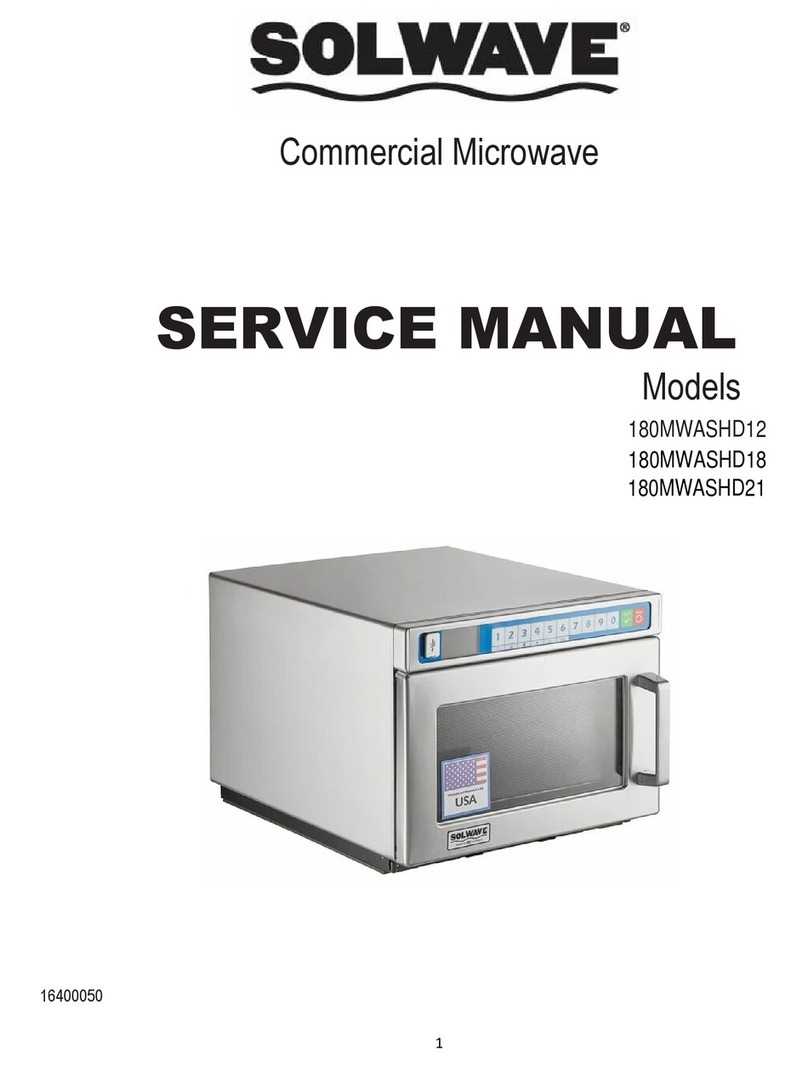
Solwave
Solwave 180MWASHD12 User manual
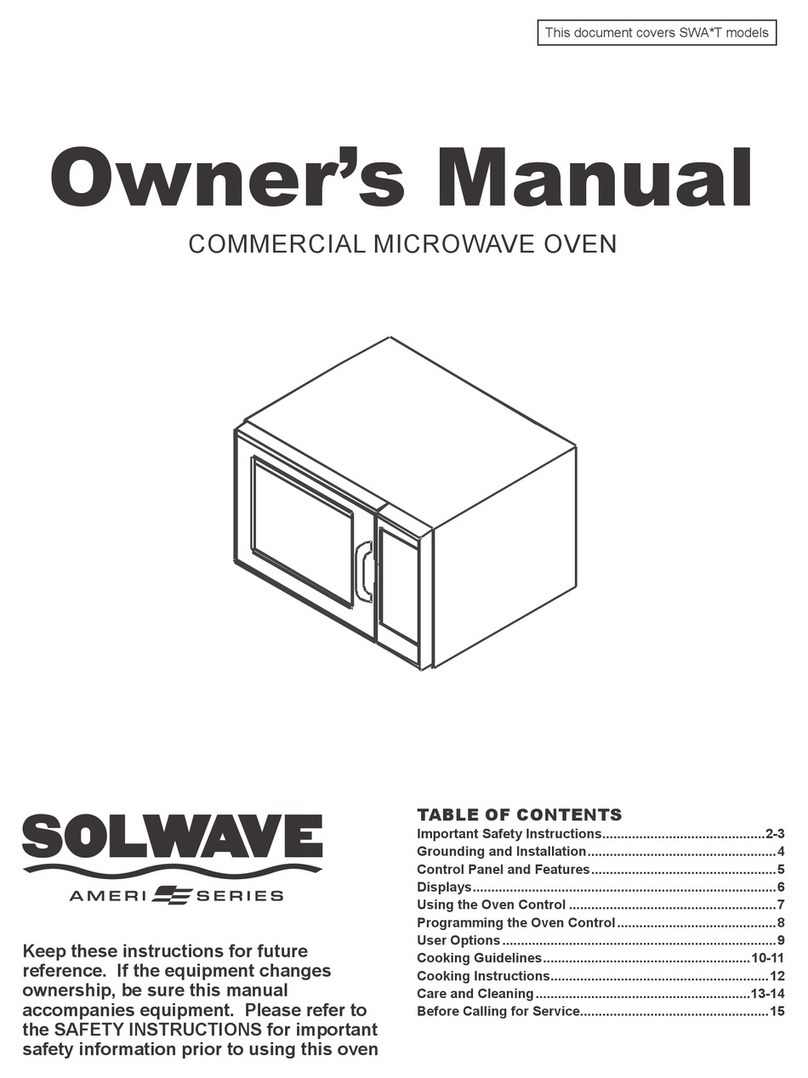
Solwave
Solwave SWA-T Series User manual
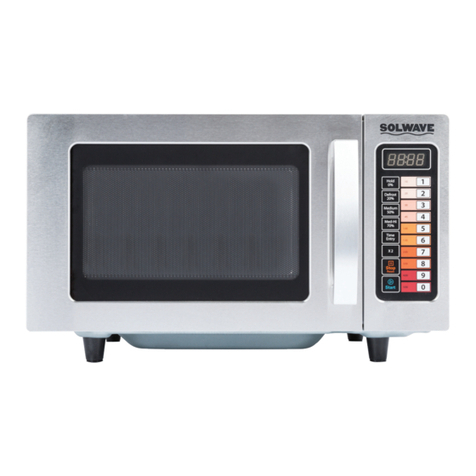
Solwave
Solwave 180MW1000SS User manual
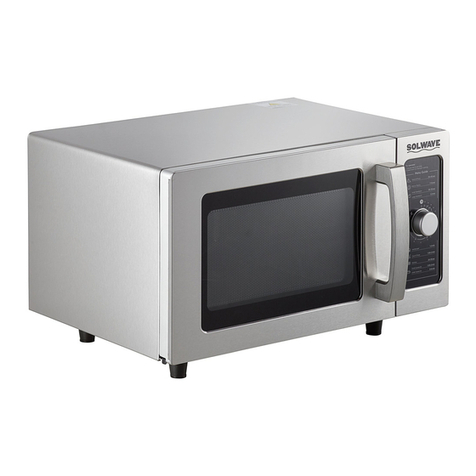
Solwave
Solwave 180MW1000D User manual
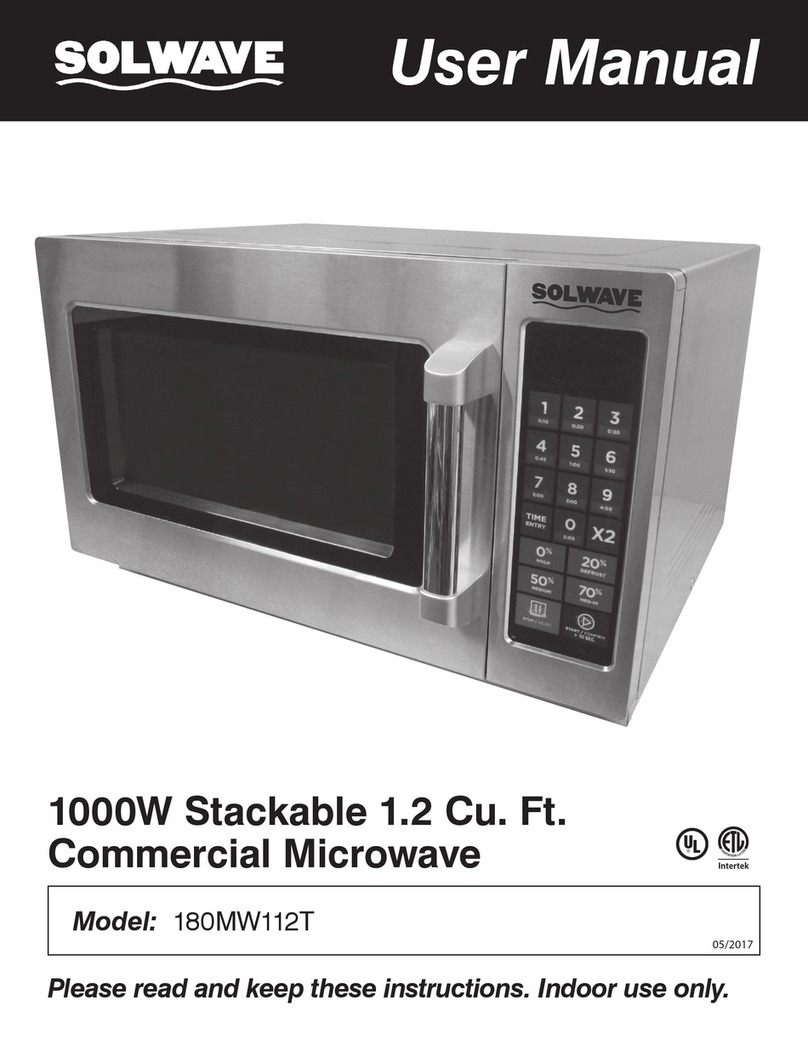
Solwave
Solwave 180MW112T User manual
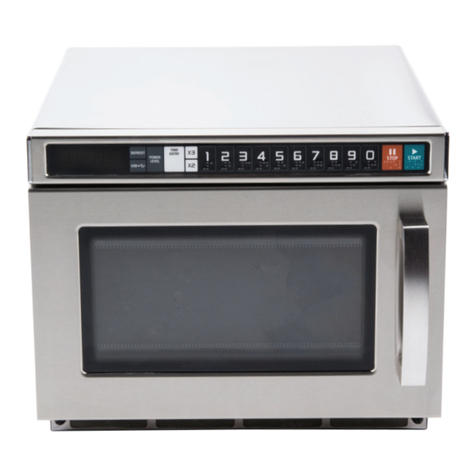
Solwave
Solwave 180MWHD12 User manual
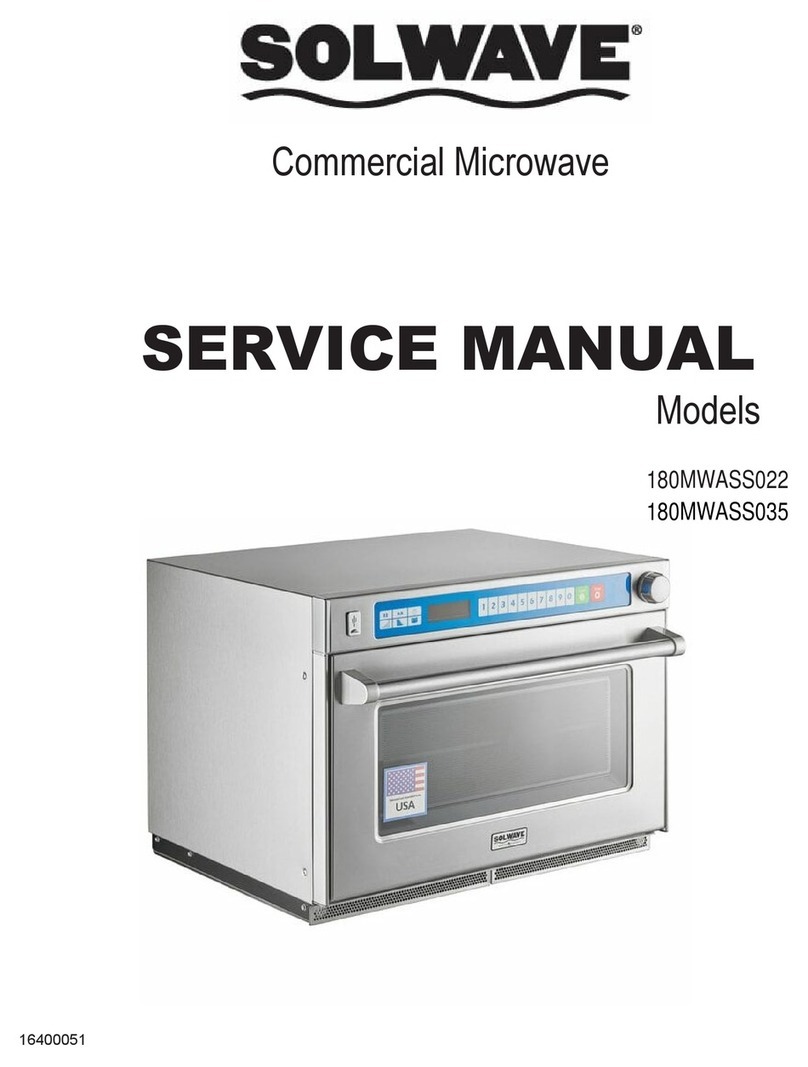
Solwave
Solwave 180MWASS022 User manual

Solwave
Solwave 180MW1000D User manual
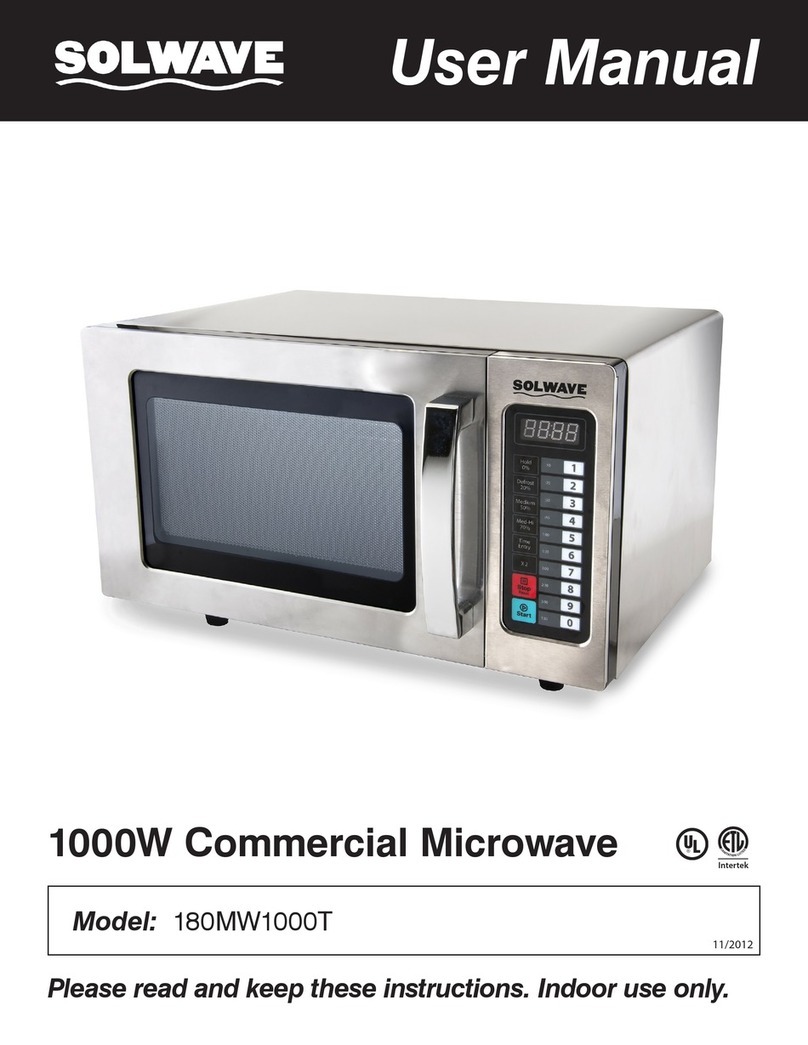
Solwave
Solwave 180MW1000T User manual
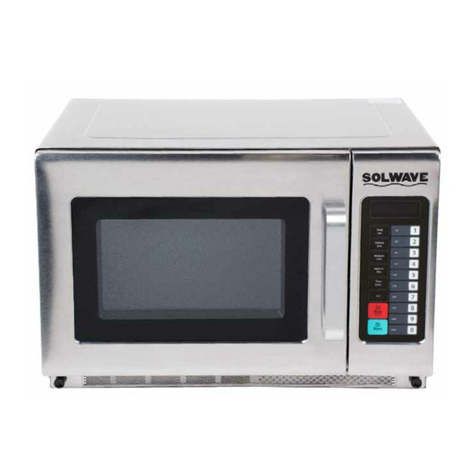
Solwave
Solwave 180MW1200T User manual

